Rose of Sharon Hibiscus syriacus Azurri Blue Satin = 'Dvpazurri' (PBR)
![rose of Sharon [Azurri Blue Satin]](/_next/image?url=https%3A%2F%2Fplants-admin.emdemapps.com%2Fimages%2Fplants%2F%2Fimages%2F604b54dd44624.png&w=3840&q=75)
ABOUT
The Hibiscus syriacus Azurri Blue Satin, commonly known as Rose of Sharon, is an ornamental shrub with a striking display of flowers. This variety boasts unique, semi-double blossoms with a rich, deep blue hue that creates a stunning visual effect in the garden. The blooms are highlighted by a contrasting magenta center, which adds to the overall vibrancy and appeal of the flower. The petals have a satiny texture that catches the light, enhancing their color and giving them a luminous quality. The Rose of Sharon's foliage provides an attractive backdrop to its showy flowers. The leaves are broadly ovate with a slight gloss and a medium to dark green shade, forming a lush, dense canopy that adds to the plant's full-bodied appearance. When in full bloom, the abundance of flowers covers the shrub, making it a focal point for any landscape. The plant's growth habit gives it a neat and upright form, adding to its elegance and making it a popular choice for hedges, borders, or as a specimen plant in a mixed border. Flowering from mid to late summer, the Rose of Sharon provides long-lasting interest and color in the garden at a time when many other plants have finished their display. The flowers also attract pollinators such as bees, butterflies, and hummingbirds, adding to the dynamic environment of the outdoor space. Overall, the Rose of Sharon Azurri Blue Satin is a resilient and captivating variety that enhances any garden with its exceptional blue flowers and stately form.
About this plant
 Names
NamesSynonyms
Azurri Blue Satin Rose of Sharon, Azurri Blue Satin Althea, Blue Satin Hibiscus.
Common names
Hibiscus syriacus Azurri Blue Satin = 'Dvpazurri' (PBR)
 Toxicity
ToxicityTo humans
Hibiscus syriacus, commonly known as Rose of Sharon, is generally recognized as a non-toxic plant to humans. There are no well-documented cases of poisoning from ingesting the plant. Consequently, accidental consumption of the flowers, leaves, or other parts should not cause any significant symptoms or long-term health consequences. Always exercise caution and avoid eating plants not confirmed as safe for consumption.
To pets
Rose of Sharon, or Hibiscus syriacus, is considered to have low toxicity for pets such as dogs and cats. However, if a pet ingests parts of this plant, mild gastrointestinal upset, including vomiting and diarrhea, could occur. In most cases, the symptoms are not severe. If a large amount is consumed, or if your animal is particularly sensitive, more serious symptoms may present themselves. Always monitor your pets around plants and consult with a veterinarian if you suspect poisoning.
 Characteristics
CharacteristicsLife cycle
Perennials
Foliage type
Deciduous
Color of leaves
Green
Flower color
Blue
Height
8 feet (2.44 meters)
Spread
6 feet (1.83 meters)
Plant type
Shrub
Hardiness zones
5
Native area
Asia
Benefits
 General Benefits
General Benefits- Attractive blooms: Hibiscus syriacus Azurri Blue Satin produces eye-catching blue flowers that add a splash of color to any landscape.
- Drought tolerance: Once established, this plant is quite tolerant of dry conditions, reducing the need for frequent watering.
- Low maintenance: Azurri Blue Satin requires minimal pruning and is generally easy to care for, making it ideal for gardeners of all levels.
- Pest resistance: It is relatively resistant to pests, which helps to avoid the application of pesticides.
- Adaptable to various soils: This hibiscus can thrive in a wide range of soil types as long as they are well-draining.
- Long blooming period: Offering flowers from mid-summer to early fall, it provides a long season of visual interest.
- Wildlife attraction: The blossoms of Azurri Blue Satin can attract pollinators such as bees and butterflies to the garden.
- Privacy screening: With its bushy growth habit, it can be used to create living screens or hedges for privacy.
- Urban tolerant: This variety of hibiscus can handle urban pollution and is suitable for city gardens.
- Compact size: It grows to a manageable size, suitable for small gardens or as a specimen in mixed borders.
 Medical Properties
Medical PropertiesThis plant is not used for medical purposes.
 Air-purifying Qualities
Air-purifying QualitiesThis plant is not specifically known for air purifying qualities.
 Other Uses
Other Uses- As a natural fabric dye: The flowers of the Rose of Sharon can be used to create a natural dye for textiles, providing shades of pink, purple, or blue depending on the mordant used.
- Ink production: Similarly, the pigments from the flowers can be extracted to make colorful, natural inks for art or writing purposes.
- Garden design: With its striking blue flowers, Rose of Sharon can be used in landscape design to create a dramatic visual impact or as a focal point in a garden setting.
- Edible landscaping: The flowers of the Rose of Sharon are edible and can be used as a decorative, colorful addition to salads or as a garnish on dishes.
- Floral arrangements: Fresh or dried flowers of Rose of Sharon can be used in floral arrangements or as part of wreaths and bouquets for their vibrant color and large blooms.
- Symbolic uses: In various cultures, Rose of Sharon is used symbolically in ceremonies or events; its symbolism can vary from immortality to delicate beauty.
- Baking decorations: The edible flowers can be candied and used to adorn cakes, pastries, or desserts for an elegant touch.
- Photography subject: Due to its striking appearance, Rose of Sharon can serve as an exquisite subject for botanical photography and art.
- Erosion control: The Rose of Sharon is an effective plant for erosion control due to its root system which can help stabilize soil in sloped gardens or areas prone to erosion.
- Habitat creation: The shrub can provide shelter and nesting sites for birds, as well as a food source for butterflies and bees, enhancing biodiversity in a garden.
Interesting Facts
 Feng Shui
Feng ShuiThe Rose of Sharon is not used in Feng Shui practice.
 Zodiac Sign Compitability
Zodiac Sign CompitabilityThe Rose of Sharon is not used in astrology practice.
 Plant Symbolism
Plant Symbolism- Feminine Energy: The hibiscus flower is often associated with feminine energy due to its delicate and exotic appearance, symbolizing beauty, charm, and grace.
- Delicate Beauty: Hibiscus flowers, with their intricate and vibrant petals, symbolize delicate beauty and a sense of sophistication.
- New Beginnings: The regular blooming of hibiscus flowers can represent new beginnings or starting afresh, as the plant tends to flower repeatedly.
- Fame and Glory: In South Korea, where the Hibiscus syriacus is the national flower, it symbolizes immortality, and is celebrated as a sign of fame and glory.
- Inviting Positive Energy: Hibiscus flowers are often used in decorations and ceremonies to invite positive energy and create a welcoming atmosphere.
 Water
WaterThe Rose of Sharon should be watered deeply and thoroughly to encourage a strong root system; typically this means providing the equivalent of 1 inch of rainfall each week. During particularly hot or dry periods, this may increase to twice per week. Always allow the top inch of soil to dry out before watering again to prevent overwatering, which can lead to root rot. To achieve this, you might use roughly 0.624 gallons for a small shrub, and adjusting proportionally as the plant scales up in size. It's important to avoid waterlogging the soil, as Rose of Sharon does not like to sit in wet soil for prolonged periods.
 Light
LightRose of Sharon thrives in full sunlight, needing at least six hours of direct, unfiltered sun each day for optimal flowering. It can tolerate partial shade, but too much shade can lead to fewer blooms and a less vigorous plant. The ideal spot would be in an area that receives morning sunlight and is protected from harsh afternoon sun in regions with extremely hot climates.
 Temperature
TemperatureRose of Sharon is a hardy plant, tolerating temperatures down to around 20 degrees Fahrenheit but it performs best in temperatures between 60 to 90 degrees Fahrenheit. Extreme cold below 20 degrees Fahrenheit may damage the plant, and prolonged exposure to temperatures over 95 degrees Fahrenheit can stress it. To ensure vigorous growth and flowering, try to maintain this ideal temperature range for the Rose of Sharon.
 Pruning
PruningPrune the Rose of Sharon in late winter or early spring before new growth begins to maintain its shape and remove any dead or diseased wood. This also encourages the growth of new shoots that will produce flowers. Pruning can be done annually, and it's the best time to shape the plant or control its size, as the Rose of Sharon blooms on new wood.
 Cleaning
CleaningAs needed
 Soil
SoilThe Azurri Blue Satin Rose of Sharon thrives in well-draining, loamy soil with a pH range of 5.5 to 7.5. A mix of two parts loam, one part peat moss, and one part perlite or coarse sand is ideal, ensuring good drainage and aeration. Regular mulching helps retain moisture and keeps the roots cool.
 Repotting
RepottingRose of Sharon typically does not need frequent repotting and can thrive outdoors in the same location for several years. Repot young plants growing in containers every two to three years to encourage growth.
 Humidity & Misting
Humidity & MistingThe Hibiscus syriacus 'Azurri Blue Satin' prefers average to high humidity levels. If grown indoors, a humidity level of around 50% is conducive to healthy growth. Outdoor plants are usually less demanding with humidity, adapting to ambient conditions.
 Suitable locations
Suitable locationsIndoor
Place in bright, indirect light. Ensure good airflow around Rose of Sharon.
Outdoor
Plant in full sun, shelter from strong winds, and moderate water.
Hardiness zone
5-9 USDA
 Life cycle
Life cycleThe Rose of Sharon 'Azurri Blue Satin' begins its life cycle as a seed, which after finding suitable conditions germinates and sends out roots and shoots. It then grows into a seedling, developing its first true leaves that allow it to start photosynthesizing and gathering energy to grow. As it matures into a young plant, it develops a robust root system and branching stems, and in its second or third year, it's capable of flowering. These flowers are hermaphroditic, bearing both male and female reproductive parts, which are followed by seed formation if pollination occurs. The plant goes through an annual cycle of flowering in late summer to fall and may undergo periods of dormancy in colder climates during the winter. Over several years, Rose of Sharon 'Azurri Blue Satin' reaches its full size, which can be up to 8-12 feet in height, and once established it can live for many years, producing flowers each season.
 Propogation
PropogationPropogation time
Spring-Early Summer
The most popular method of propagation for the Hibiscus syriacus, commonly known as Rose of Sharon, is by softwood cuttings. This is typically done in late spring to early summer when new growth is mature enough to be cut yet still tender. You should take cuttings that are about 4 to 6 inches long (10 to 15 cm), making sure each cutting has at least a couple of leaves. The cut end is dipped in rooting hormone and then placed in a well-draining potting mix. It's important to maintain a humid environment for the cuttings, so covering the pot with a plastic bag or placing it in a greenhouse can be beneficial. Root development may take several weeks, and once rooted, the young plants can be gradually acclimatized to less humid conditions before being transplanted outside.
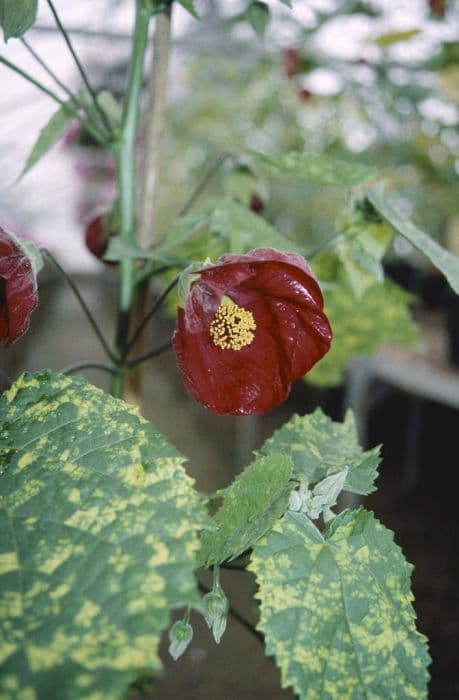
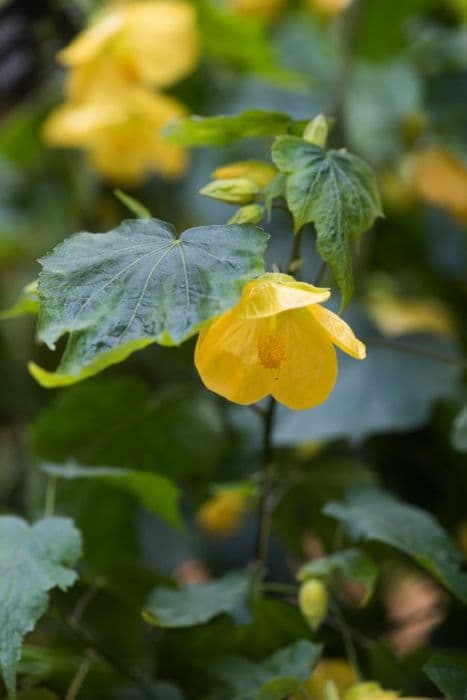
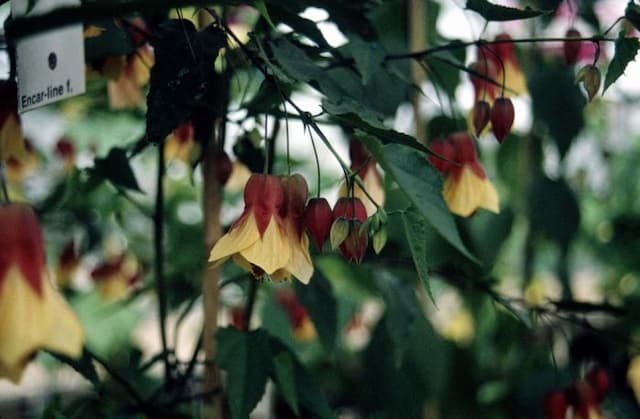
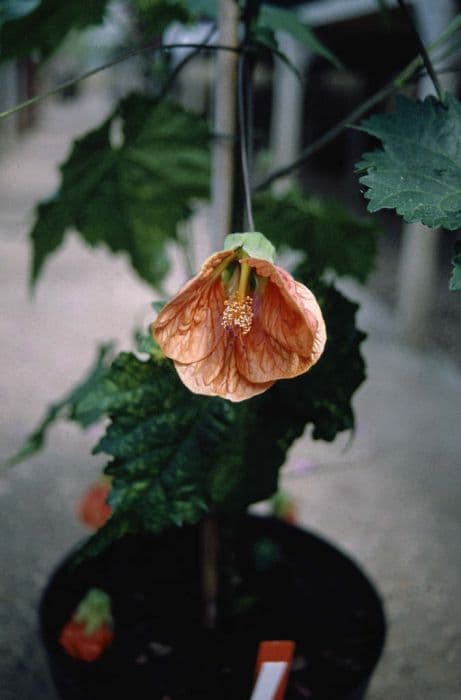
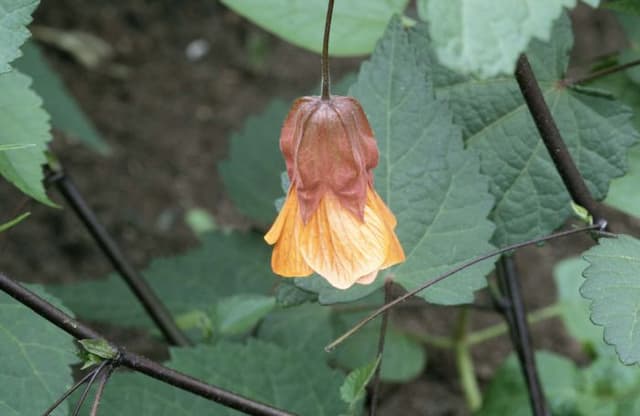

![Abutilon [Yellow Trumpet]](/_next/image?url=https%3A%2F%2Fplants-admin.emdemapps.com%2Fimages%2Fplants%2F%2Fimages%2F604b5caa8b4fb.png&w=640&q=75)

